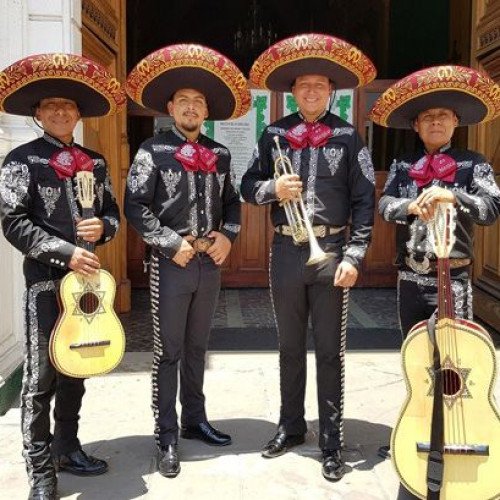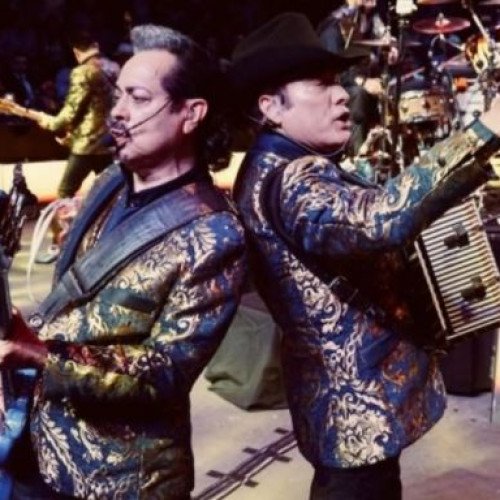Latin American musical genres

Mariachi
Mariachi (US: /ˌmɑːriˈɑːtʃi/, UK: /ˌmær-/, Spanish: [maˈɾjatʃi]) is a genre of regional Mexican music that dates back to at least the 18th century, evolving over time in the countryside of various regions of western Mexico. The usual mariachi group today consists of as many as eight violins, two trumpets and at least one guitar, including a high-pitched vihuela and an acoustic bass guitar called a guitarrón, and all players taking turns singing lead and doing backup vocals. From the 19th to 20th century, migrations from rural areas into Guadalajara, along with the Mexican government's cultural promotion gradually re-labeled it as son style, with its alternative name of mariachi becoming used for the 'urban' form. Modifications of the music include influences from other music such as polkas and waltzes, the addition of trumpets and the use of charro outfits by mariachi musicians. The musical style began to take on national prominence in the first half of the 20th century, with its promotion at presidential inaugurations and on the radio in the 1920s. In 2011, UNESCO recognized mariachi as an Intangible Cultural Heritage, joining six other entries on the Mexican list of that category.[1] Song styles and instrumentals performed with mariachi include rancheras, corridos, cumbias, boleros, ballads, sones, huapangos, jarabes, danzones, joropos, pasodobles, marches, polkas, waltzes and chotís. Most song lyrics are about machismo, love, betrayal, death, politics, revolutionary heroes and country life. On November 24, 2020, Google dedicated its Google Doodle to mariachi.
Statistics for this Xoptio

Corridos
The corrido (Spanish pronunciation: [koˈriðo]) is a popular narrative metrical tale and poetry that forms a ballad. The songs are often about oppression, history, daily life for criminals, and other socially relevant topics.[1] It is still a popular genre today in Mexico and even gained some popularity in the U.S. more specifically in California and Texas. Corridos were widely popular during the Mexican Revolutions of the 20th century. The corrido derives largely from the romance, and in its most known form consists of a salutation from the singer and prologue to the story, the story itself, and a moral and farewell from the singer. Outside Mexico corridos are popular in Chilean national-day celebrations of Fiestas Patrias. Corridos play an important part in Mexican and Mexican American culture. The name origin comes from the Spanish word meaning "to run" in Spanish this would be "correr". The formula of a standard corrido is of eight quatrains that have four to six lines that contain eight syllables.[4] Corridos have a long history in Mexico, starting from the Mexican War of Independence in 1810 and throughout the Mexican Revolution.[5] Until the arrival and success of electronic mass-media (mid-20th century), the corrido served in Mexico as the main informational and educational outlet, even with subversive purposes, due to an apparent linguistic and musical simplicity that lent itself to oral transmission. After the spread of radio and television, the genre evolved into a new stage and is still in the process of maturation. Some scholars, however, consider the corrido to be dead or moribund in more recent times (see e.g. Vicente T. Mendoza, El corrido mexicano, 1954). In more rural areas where Spanish and Mexican cultures have been preserved because of isolation, the romance has taken on other forms related to the corrido as well. In New Mexico, for example, a story-song emerged during the colonial period that was known as an Indita, which loosely follows the format of a corrido, but is chanted rather than sung, similar to a Native American chant, hence the name Indita. The earliest living specimens of corrido are adapted versions of Spanish romances or European tales, mainly about disgraced or idealized love, or religious topics. These, that include (among others) "La Martina" (an adaptation of the romance "La Esposa Infiel") and "La Delgadina", show the same basic stylistic features of the later mainstream corridos (1/2 or 3/4 tempo and verso menor lyric composing, meaning verses of eight or less phonetic syllables, grouped in strophes of six or less verses).